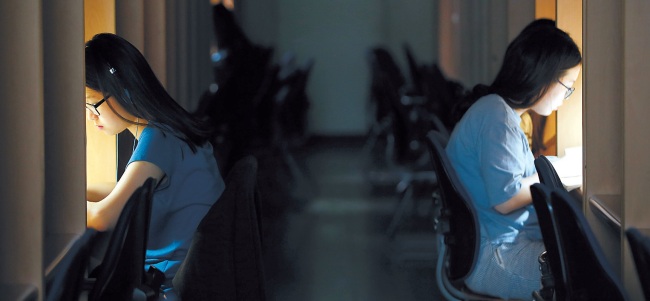Female students who took the college entrance exam ― known here as the “Suneung” ― last year garnered higher scores in all major subjects compared to their male counterparts, the state-run Korea Institute for Curriculum and Evaluation said Tuesday.
According to KICE data, the gender disparity was more profound in the Korean Language and English categories, in which female students have generally done better than their male counterparts. Girls got 5.4 more points in standard scores in Korean Language type B category ― the Suneung math and Korean sections are conducted in two sets of tests, an easier type A and more difficult type B.
Math type B, the only subject where boys outperformed girls in the 2013 Suneung, was also taken over by girls, although the disparity was the smallest among all subjects at 0.4.
The data reflected the recent trend of female students outperforming their male counterparts in school work.
According to KICE data, the gender disparity was more profound in the Korean Language and English categories, in which female students have generally done better than their male counterparts. Girls got 5.4 more points in standard scores in Korean Language type B category ― the Suneung math and Korean sections are conducted in two sets of tests, an easier type A and more difficult type B.
Math type B, the only subject where boys outperformed girls in the 2013 Suneung, was also taken over by girls, although the disparity was the smallest among all subjects at 0.4.
The data reflected the recent trend of female students outperforming their male counterparts in school work.

According to an analysis of the KICE’s evaluation on academic achievement of middle and high school students, girls had a profound lead in both Korean Language and English ― by 8.3 to 10.7 points ― while boys only had a minor advantage of 1.1 in high school math.
“In secondary education, girls tend to be more diligent and hardworking than boys. They also pay more attention to detail, which helps because most of our exams are about getting the facts right,” said an English teacher at a Seoul-based middle school.
A five-year analysis of the data also showed that the boys’ lead in the math category had consistently shrunk since recording 3 points average higher disparity in 2010, while girls maintained a steady lead in the two other categories.
While girls generally did better than boys in recent Suneung exams, experts say that girls’ dominance in Math type B is likely to have been a result of authorities’ failure to balance out how difficult each subject is.
For example, 4.3 percent of the students got the perfect score in Math type B, but only 0.09 percent aced the Korean Language type B.
Based on the nine-level grading system, those who took Math B had to have scored perfect marks to be graded in the top level, as the test was relatively too easy.
“Because last year’s Suneung had such easy math exams, boys had a harder time showing better grades on the test that failed to distinctively assess the students’ capacity,” said Yang Jung-ho, a professor of education at Sungkyunkwan University.
Girls, on the other hand, had a significant advantage in doing well in what they already excelled in on the test that was much more difficult, he added.
He pointed out that 4 percent of male students got the top rating in Math type B, while 1.9 percent of the female students garnered the top rating. In the case of both Math type A and B, more male students received the top rating than their female counterparts.
In addition to gender disparity, there were also substantial differences in the performances of students from large cities and rural areas.
In terms of standard scores, students from large cities ― those with a population of 500,000 or more ― scored as much as 11.6 points more than those from rural areas.
Yang said this is because those living in metropolitan areas tend to have higher incomes as well as more access to private language education and information related to education, which allows them to be more committed to their children’s education than those in rural areas.
By Yoon Min-sik
(minsikyoon@heraldcorp.com)









![[Hello India] Hyundai Motor vows to boost 'clean mobility' in India](http://res.heraldm.com/phpwas/restmb_idxmake.php?idx=644&simg=/content/image/2024/04/25/20240425050672_0.jpg&u=)









